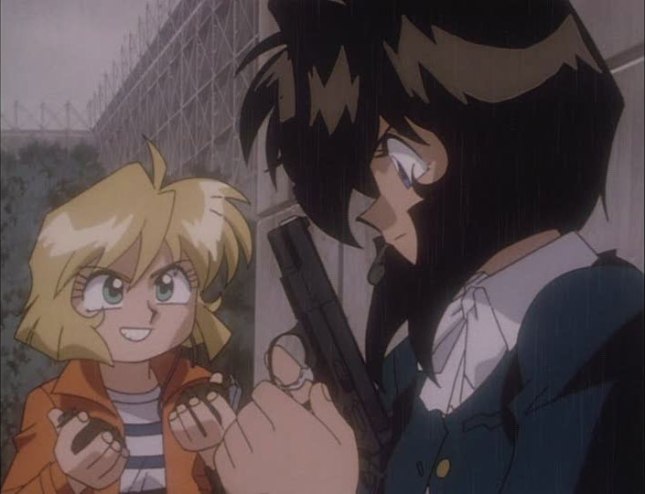- Episodes: 3
- Produced: 95 (JP), 01 (US)
Rally Vincent and her partner May Hopkins are a pair of bounty hunters that own a gun shop called “Gun Smith Cats”. Living in an 80’s vision of Chicago, the pair work together to make whatever money they can with bounty hunting to support themselves, though jobs are few and far between, and there’s always more bills. Rally’s the older of the two, owner of the store and head of their duo. An expert with guns, she shows an amazing talent for recognition and understanding of many different varieties as well. May on the other hand can barely use a gun. She more than makes up for it with her skill with explosives. From grenades of all shapes and sizes to use of C4 and other explosive gels, May ends up causing more damage than she really helps.
Things seem to be looking up when they make a bust on a man named Washington on drug smuggling charges, only to find out the police couldn’t find any. Instead of a nice pay off, they end up running into an agent of the ATF (Department of Alcohol, Tobacco, and Firearms, for you non-US people). Going by the name of Bill, he blackmails the girls with a lack of proper licensing for their shop, getting them to work for the ATF. As it turns out, the guy they busted for drug smuggling was really working with illegal firearms. Bill wants the girls to work with Washington to find out everything they can about the weapons smuggling and how deep it goes. He needs outside help because he suspects someone within the ATF is helping the smugglers, so he needs someone on the outside. Left with little choice, Rally agrees to help him out.
Things quickly get over everyone’s head unfortunately. The ring seems to be much larger than Bill thought, putting the girls along with himself in the line of fire. The girls are attacked in their own home, the smugglers end up hiring an assassin, and the connections end up going to the most unexpected places. There doesn’t promise to be a lot of money in it, making it all a real pain in the ass for Rally, but she ends up too deep to get out without a fight!
At only an hour and a half, Gunsmith Cats is an OVA that feels almost like a movie with small breaks. It’s a highly detailed anime with a lot of work going into the guns, the cars, the city of Chicago, and even the uniforms and clothes. The soundtrack adds to the 80s action feel with an upbeat jazz sound that reminds me a little of Cowboy Bebop or Read or Die. All of that detail adds up to that movie feel, with a plot designed to mirror a cop drama movie in the Die Hard or Lethal Weapon. It’s full of tropes, but they mirror their American movie inspiration as much if not more than the anime tropes that weave their way in.
Because of the old cheesy action flick feel of the anime, the plot has plenty of twists and turns, yet it doesn’t feel very deep. It’s not trying to be of course, focusing more on the constant suspense of intense action to keep your interest. Thankfully, with all the work that went into the production values, along with the tight run time, Gunsmith Cats feels just the right length to keep action packed without being too drawn out. If anything, it leaves you wanting another story in the girl’s lives, something the manga did with a long print run and sequel.
It should be pretty obvious after all said that I’m recommending Gunsmith Cats, and in fact I can’t recommend it enough. It’s not a life changing “experience” that you’ll be debating the complexity of for years, nor is it an epic sprawling story with 2 or 3 seasons of development. It lives off quick suspenseful action, guns, girls, cars, corruption, tragedy, and perseverance. If you like action flicks, if you like the 80s, if you like quick somewhat over the top fun, then this OVA is for you. I’d say it’s even worth paying a little extra for, though you won’t need to.
Now, in the title I also mentioned Riding Bean. Made by the makers of Gunsmith Cats, Riding Bean has the same 80s action feel to it, though more so if anything. Predating Gunsmith Cats, Riding Bean only got one 40 minute episode before it ended, making it hard to justify as a solo buy (or review). Featuring a prototype of Rally as the assistant to Bean Bandit, a courier for hire, Riding Bean kicks up the blood, the corruption, the guns, and the cars. Though the creator Kenichi Sonoda preferred Riding Bean, the producers liked the Gunsmith Cats idea more and worked with that more rather than Riding Bean. In the end, I tend to agree with the choice. Riding Bean may have the disadvantage of being a shorter anime to begin with, but Riding Bean seems to lack the more approachable parts of Gunsmith Cats. Bean Bandit ends up being a lot more of a superhuman bad-ass with little to no personality than the more complex Rally and May. Still, if you end up watching Gunsmith Cats and find Riding Bean on an anime streaming sight, giving it a watch couldn’t hurt.






